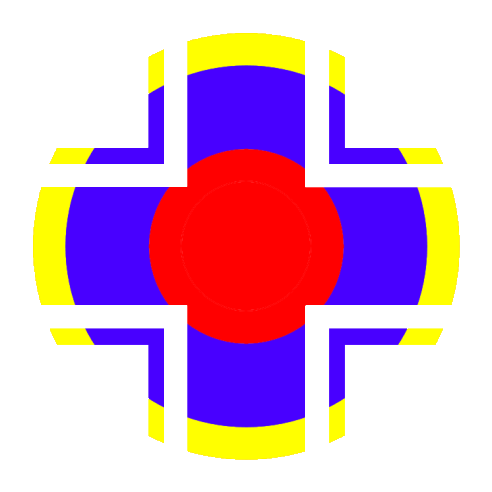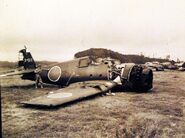(Adding categories) |
(Made category Category:Grumman F4F Wildcat) Tag: Visual edit |
||
| (2 intermediate revisions by the same user not shown) | |||
| Line 14: | Line 14: | ||
The wreckage of this largely intact Hellcat was recovered by personnel from Kobi Airfield and displayed at Kobi Shrine for a time. Later, it was transported to Japan and operated from Yokosuka Airfield. A Japanese Hinomaru (rising sun) markings, over painting the American markings and applying tail number ヨ-801 (Yokosuka Kōkūtai). At the end of the war it was abandoned at Yokosuka Airfield on its belly, likely after making a force landing. The aircraft was partially stripped with the propeller, engine cowling and cockpit canopy removed and fabric surfaces missing. During September 1945, the wreckage was found by US forces. After capture, the wreckage was moved and subjected to a further removal of parts. The ultimate fate of BuNo 71441 is unknown, it was likely scrapped or has otherwise disappeared.<ref name="pacificwrecks71441" /> |
The wreckage of this largely intact Hellcat was recovered by personnel from Kobi Airfield and displayed at Kobi Shrine for a time. Later, it was transported to Japan and operated from Yokosuka Airfield. A Japanese Hinomaru (rising sun) markings, over painting the American markings and applying tail number ヨ-801 (Yokosuka Kōkūtai). At the end of the war it was abandoned at Yokosuka Airfield on its belly, likely after making a force landing. The aircraft was partially stripped with the propeller, engine cowling and cockpit canopy removed and fabric surfaces missing. During September 1945, the wreckage was found by US forces. After capture, the wreckage was moved and subjected to a further removal of parts. The ultimate fate of BuNo 71441 is unknown, it was likely scrapped or has otherwise disappeared.<ref name="pacificwrecks71441" /> |
||
<gallery navigation="true"> |
<gallery navigation="true"> |
||
| − | F6f-force-landed-kobi.jpg|As the Japanese found it|link=https://www.pacificwrecks.com/aircraft/f6f/71441/f6f-force-landed-kobi.html |
+ | F6f-force-landed-kobi.jpg|As the Japanese found it|link=https://www.pacificwrecks.com/aircraft/f6f/71441/f6f-force-landed-kobi.html |
F6F-5.29.jpg|Back to Kobi |
F6F-5.29.jpg|Back to Kobi |
||
30267672180 bbfc3ecd57 o.jpg|As the US forces found it again |
30267672180 bbfc3ecd57 o.jpg|As the US forces found it again |
||
| + | 30267672380_0705001e18_o.jpg |
||
| + | 17834210_1316723605031843_2831232315159247574_o.jpg |
||
| + | 17492821_1316723621698508_8754844792567462704_o.jpg |
||
</gallery> |
</gallery> |
||
| Line 22: | Line 25: | ||
<references /> |
<references /> |
||
[[Category:World War 2]] |
[[Category:World War 2]] |
||
| + | [[Category:Grumman F6F Hellcat]] |
||
Latest revision as of 21:04, 1 July 2018
History[]
Built by Grumman. Delivered to the US Navy as a F6F-5 Hellcat, BuNo 71441. Assigned to the USS Langley (CVL-27). Assigned to squadron VF-44 with tail code "29". No known nickname or nose art.[1]
US Operational History[]
On 4 January 1945 at 7:15am BuNo 71441 took off from the USS Langley (CLV-27) on a mission to escort six Grumman TBF Avengers attacking Kobi on Formosa. BuNo 71441 was leading the second division of Hellcats, tasked with strafing parked planes at Kobi Airfield. Over the target, this Hellcat suffered an engine failure and force landed near Kobi Airfield. When this aircraft failed to return, its pilot was listed as Missing In Action (MIA).[1]
In Japanese hands[]
The wreckage of this largely intact Hellcat was recovered by personnel from Kobi Airfield and displayed at Kobi Shrine for a time. Later, it was transported to Japan and operated from Yokosuka Airfield. A Japanese Hinomaru (rising sun) markings, over painting the American markings and applying tail number ヨ-801 (Yokosuka Kōkūtai). At the end of the war it was abandoned at Yokosuka Airfield on its belly, likely after making a force landing. The aircraft was partially stripped with the propeller, engine cowling and cockpit canopy removed and fabric surfaces missing. During September 1945, the wreckage was found by US forces. After capture, the wreckage was moved and subjected to a further removal of parts. The ultimate fate of BuNo 71441 is unknown, it was likely scrapped or has otherwise disappeared.[1]






